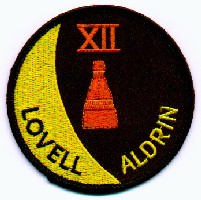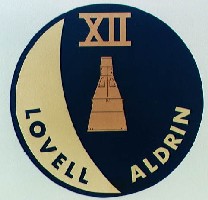

The Mission
The final Gemmini mission crews were selected on June 17, 1966. The prime crew would be: James A. Lovell, Jr., and Edwin E. Aldrin, Jr.. And the back-up crew: L. Gordon Cooper and Eugene A. Cernan.
The final flight of the Gemini program began on November 11, 1966. On launch day the Atlas-Agena liftoff occured at 2:07:59 pm EST, one second earlier than planned. This launch was followed by the Gemini-XII liftoff at 3:46:33 pm, within a half-second of the planned time.
Gemini-XII was designed to gain additional information about the extravehicular activity requirements, to rendezvous and dock with a target, and to perform a number of experiments. In addition to achieving these and other objectives command pilot James Lovell and pilot Edwin Aldrin set several individual space records. Lovell has logged more hours in space than any other man (425 hours, 9 minutes, and 31 seconds.) Aldrin logged more EVA time than any other man; a two hour and 29-minute standup EVA; a two hour and six-minute umbilical EVA; and another 55-minute standup EVA for a total of 5 hours and 32 minutes. the crew also performed some 14 experiments. These activities were spread over the four days of flight. Use of handrails, foot restraints, and waist tethers during the umbilical EVA period proved to be most effective and Aldrin completed all 19 assigned tasks.
Retrofire was initiated over Canton Island at 93 hours, 59 minutes, and 32 seconds MET. The landing occured 34 minutes and 32 seconds later at 2:21:04 pm November 15, 1966.Landing was within 2.6 miles of the planned landing point. The flotation collar was attached eight minutes after splashdown and Lovell and Aldrin were picked up by helicopter and taken to the deck of the USS Wasp at 2:49 pm. The last Gemini spacecraft to fly in the program was brought aboard the USS Wasp at 3:28 pm.
The Artwork
The Gemini program ended with Gemini-12, the tenth crewed flight of the series. Jim Lovell and Edwin Buzz Aldrin, crew memebers for this final mission, had toyed with the idea of featuring two astronauts on broomsticks as the central feature of their patch as the flight was originally planned for launch around Halloween 1966.
After some difficulty in coming up with a suitable design the crew chose a simple but effective design wich featured an outline of a Gemini spacecraft pointing like an hour hand on a clock towards the Roman numeral XII, the mission designation and also Halloween's symbolic "witching hour". A crescent moon was added to te design on the left side, not only for its association with Halloween but also because this was the last Gemini flight prior to the Apollo lunar missions.

The patch featured the traditional Halloween colours of gold, orange and black and the artwork was completed by McDonnel Douglas artists.
Although known as the "Halloween patch" the mission did not actually take place until mid November 1966. The names of the crew also
appear on the patch wich was worn on the upper right sleeves of their spacesuits.